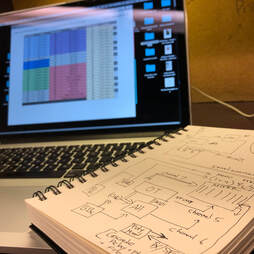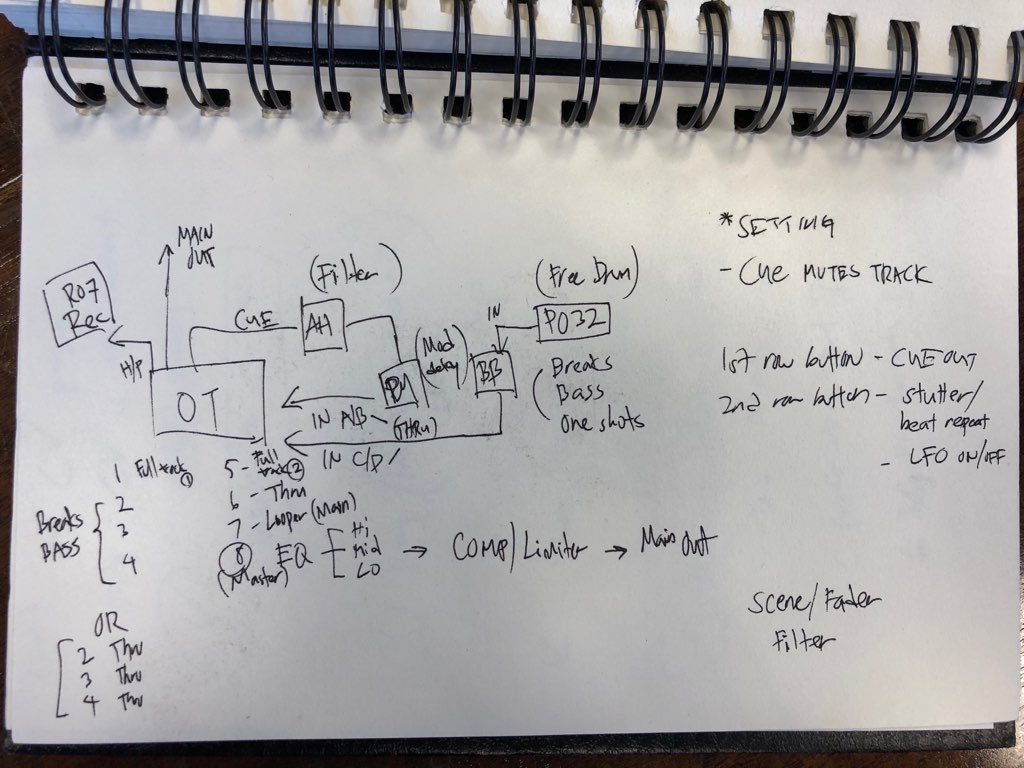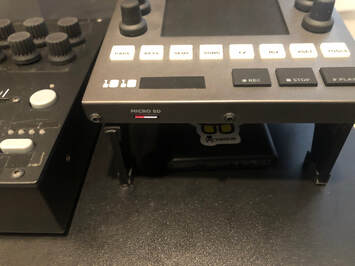Performative interface designing for quadraphonic sound systems
My preferred approach is to work with tactile controllers, so the quickest way I found to get a prototype going is to use available midi controllers and hardwares, and combine them like modular signal processors (i.e. ad-hoc Eurorack systems).
My preferred approach is to work with tactile controllers, so the quickest way I found to get a prototype going is to use available midi controllers and hardwares, and combine them like modular signal processors (i.e. ad-hoc Eurorack systems).
Challenges one may encounter when designing interfaces going from static to mobile, is the selective process of scaling down.
By scaling down, one has to become mindful of performance situations, particularly to think about mapping of the controlling interface; having to remember too many functions can hinder muscle memory and swiftness needed for successful improvisations.
Experiencing a performance as a performer really helps the R&D process.
I find that the less menu-diving, the better chance of accessing flow state performance.
Certain features, such as having at least 4 channel outputs, must be considered when scaling down for spatial audio.
Just like any product developing, the user researcher becomes indispensable because of the default limitations one must brush up against.
By scaling down, one has to become mindful of performance situations, particularly to think about mapping of the controlling interface; having to remember too many functions can hinder muscle memory and swiftness needed for successful improvisations.
Experiencing a performance as a performer really helps the R&D process.
I find that the less menu-diving, the better chance of accessing flow state performance.
Certain features, such as having at least 4 channel outputs, must be considered when scaling down for spatial audio.
Just like any product developing, the user researcher becomes indispensable because of the default limitations one must brush up against.
Dynamic Performance System (DPS)
The DPS combines ready-made hardware and software via midi, wifi, ethernet, and OSC, to enable the performer, individually or collectively, to control and mangle sounds, improvise musical sequences, and simultaneously “perform” visual projections for various contexts.
DPS Version 1.0 (DPS-1) combines the Octatrack, Launchpad XL, Analog Heat mk2, BlackBox sampler/control voltage (CV) controller, Polymoon modulated delay pedal, 12 channel Mackie mixer, Optoma X600 projector, and Eyesy video synthesizer.
Sounds/samples/loops can be assigned to slots, midi-triggered, and its musical attributes can be manipulated in real-time (ex. pitch, tempo, trigger count, sample start and length). From there, the performer can apply effects to the rearranged loop, resample it, and start the cycle all over, if needed.
Sounds/samples/loops can be assigned to slots, midi-triggered, and its musical attributes can be manipulated in real-time (ex. pitch, tempo, trigger count, sample start and length). From there, the performer can apply effects to the rearranged loop, resample it, and start the cycle all over, if needed.
DPS ver. 1.5
Intentionally limiting the rig size for mobility poses its own challenges. I am constantly adding and subtracting modules because hardwares physically take up space and weight.
Subtraction: I replaced the mixer with Analog Heat mk2 for the master signal chain, which still gives the performer control of sound sculpting and saturation. It is also gets rid of the need to haul around the DJ stand, which is a significant weight.
By losing those extra pounds, I'm able to replace it with other sound mangling modules.
Additions: Roland Scooper for Scatter and Looping duties, which injects musicality and surprise element to loops; Pocket Operator is a hand held drum machine for on-the-fly additional layer of beats; Korg Kaos Pad mk3 for multi FX assigned to XY pad gestures.
Intentionally limiting the rig size for mobility poses its own challenges. I am constantly adding and subtracting modules because hardwares physically take up space and weight.
Subtraction: I replaced the mixer with Analog Heat mk2 for the master signal chain, which still gives the performer control of sound sculpting and saturation. It is also gets rid of the need to haul around the DJ stand, which is a significant weight.
By losing those extra pounds, I'm able to replace it with other sound mangling modules.
Additions: Roland Scooper for Scatter and Looping duties, which injects musicality and surprise element to loops; Pocket Operator is a hand held drum machine for on-the-fly additional layer of beats; Korg Kaos Pad mk3 for multi FX assigned to XY pad gestures.
DPS Version 2.0 (DPS-2) scales down the system further, making it even more mobile without compromising improvisational performability. The mainframe of the system is still the Octatrack (4 audio out) and BlackBox sampler, but the Launchpad XL, Analog Heat mk2, Polymoon modulated delay pedal, and 12 channel Mackie mixer is shaven off and replaced by SP404 multi FX.
*Optoma X600 projector, and Eyesy video synthesizer remains but is on a modular island next to the main DPS.
*Optoma X600 projector, and Eyesy video synthesizer remains but is on a modular island next to the main DPS.
DPS Version 3.0 "Spatial Audio Front/Back style (SA1)" (DPS-3SA1) my go-to interface layout for controlling quadraphonic. Deployed at music events around Somerville and Cambridge, including Space Invaders, Dissolve Music, the Somerville Museum, and MIT campus.
The third iteration of DPS seen here uses Ableton + Max4Live as the main facilitator, and Oto Machine Bam Reverb, Midi fighter Twister, and LaunchcontrolXL.
Still mobile, still very capable. And spatial sound ready!
Still mobile, still very capable. And spatial sound ready!
For this version, I dive into building FX racks inside Ableton.
I wanted to create a chain of delay, reverb, and filters combined for a broad range of complex sounds. The delay chain provides animation and rhythmic movement to incoming audio. The delay divisions are also controllable, for both the left and right channels for delays that bounce around the stereo spread. The performer can also add an offset between the left and right delays for fantastic ping-pong delay effects. The addition of a dual pulse delay, adds another layer of complexity, bringing the total number of taps to the delay.
Both the delay lines have a filter to carve out the delay lines' harmonics. These filter knobs feature low pass filtering to the left and high pass filters to the right. I used a free DJ filter effect plug in by Xfer for this. The primary delay filters can either come before or after the effect.
At the end of the chain, the performer can add space to the delay lines using the reverb section— the amount, reverb size can be adjusted and I've added a high pass filter after the reverb for the performer to sculpt out the perfect reverb sound. And finally an LFO to modulate panning parameters, synced or unsynced modes, gives the sounds a constant shift with a lush, organic live feel.
I wanted to create a chain of delay, reverb, and filters combined for a broad range of complex sounds. The delay chain provides animation and rhythmic movement to incoming audio. The delay divisions are also controllable, for both the left and right channels for delays that bounce around the stereo spread. The performer can also add an offset between the left and right delays for fantastic ping-pong delay effects. The addition of a dual pulse delay, adds another layer of complexity, bringing the total number of taps to the delay.
Both the delay lines have a filter to carve out the delay lines' harmonics. These filter knobs feature low pass filtering to the left and high pass filters to the right. I used a free DJ filter effect plug in by Xfer for this. The primary delay filters can either come before or after the effect.
At the end of the chain, the performer can add space to the delay lines using the reverb section— the amount, reverb size can be adjusted and I've added a high pass filter after the reverb for the performer to sculpt out the perfect reverb sound. And finally an LFO to modulate panning parameters, synced or unsynced modes, gives the sounds a constant shift with a lush, organic live feel.










